
Connect With Us
Let’s create something extraordinary. Connect with Sunrise Technologies today!
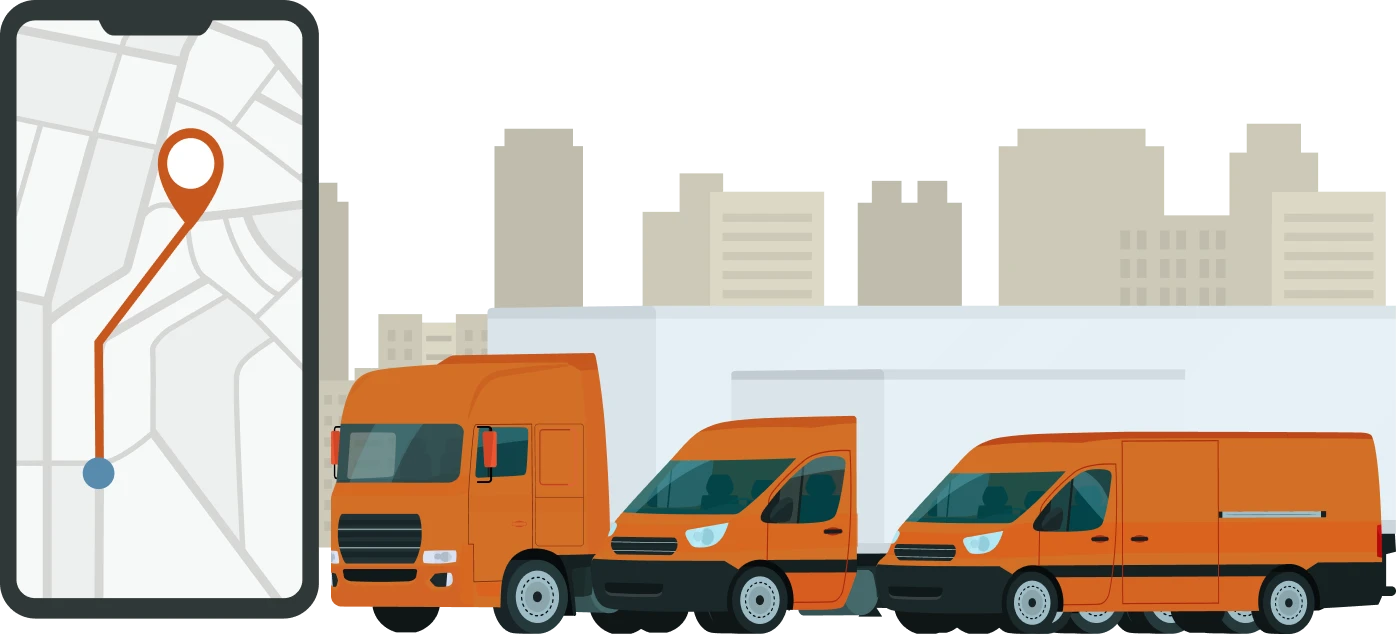
April 02, 2024
Most enterprises heavily depend on their fleet. Especially when it comes to overall success and daily operations. You are part of an industry that utilises vehicles. It can be construction, agriculture or transportation. Whatever the category is, without proper management and maintenance, it can lead to huge concerns. Fleet plays a very crucial role across various industries. They are responsible for the distribting of goods that are manufactured. Fleet also ensures the movement of products in the supply chain.
In the present day, during the evolution of technology, the fleet industry is changing very fast. The operators of the fleet use tracking of the fleet in actual time. They also monitor systems in their vehicles. Especially with Vehicle monitoring software. They also accept the technology for solving complicated operations.
Management of fleet relies on technologies of IoT. It is used for controlling and monitoring in actual time. IoT helps in enabling data collection from vehicles. It allows you to track efficiently and optimise routes. They also allow preventive maintenance. It also makes safety improvements; it decreases costs and elevates productivity. It increases by providing automation and insights that are valuable. It optimises the performance of the entire fleet.
The Internet of Things (IoT) was supposed to be a futuristic object. It is tailored to make our lives simple providing hassle-free daily work. It takes control of most of our manual work. However, there has been wonderful growth in IoT in the past few years. It has also created huge impacts on our daily lives. It has made things easier and faster for us. One-third of spending around the globe for IoT is accounted for by three active commercial sectors. The three sectors are process manufacturing, discrete manufacturing and transportation. Thus, IoT is making a true transformation in fleet management.
In many trends of management of fleet that are driven by IoT. They make changes in the management of the industry of fleet. Where changes are being made smartly with capabilities and skills. Better management of vehicles is involved over here. It also enhances data-driven insights and activities in the consumption of fuel.
According to a report, IoT fleet management in the global market was more than USD 3000 million. According to the trend, it witnessed an extreme rise from the year 2017 to 2024. The revenue of the market of IoT fleet management is expected to go beyond USD 15000 million. That too by the end of the forecast period.
Along with that, according to Statista, there are 35 billion devices connected in 2021. It is expected to reach around or more than 75 billion in 2025. The trend is gaining popularity in the transportation sector on a large scale. It is where the technology of IoT is applied successfully in the management of a fleet.
Integrating sensors of IoT and tracking of GPS. It improves the efficiency of the fleet through data analytics. It also helps in making improvements for the safety of the driver. It also enables enhanced decision-making. As businesses understand the important advantages of solutions of IoT management of fleet. The market is said to continue to grow in the upcoming years.
As one of the trends in technology that is growing fast, IoT offers the advantages of attached infrastructure from across the world. Most of the businesses have already started grasping the possibility of IoT fleet management actively.
Operators of fleets are grasping the advantages of IoT all around the world. It is to decrease the cost of ownership. It is also used in maintaining the fleet and performing analysis of performance. In this article, we will see how IoT is transforming the technological aspects of fleet management.
Through this article, we will provide a complete analysis of fleet management based on IoT. And what is included in it. We will explain the intention of IoT fleet management. This article will also highlight the advantages of telematics technology. It would also include applications of IoT and its use cases and benefits in fleet management. We will also look into how you can grasp the capabilities of IoT in this process of automation. And enhancing decision-making and optimising costs.
With telematics and IoT organisation between vehicles of large numbers becomes more mechanised. Especially if it has been performed previously with clumsy logistics. Businesses can make hassle-free monitoring and controlling of their assets. It decides on the performance and health of its fleet. It also helps in keeping track of the repair status.
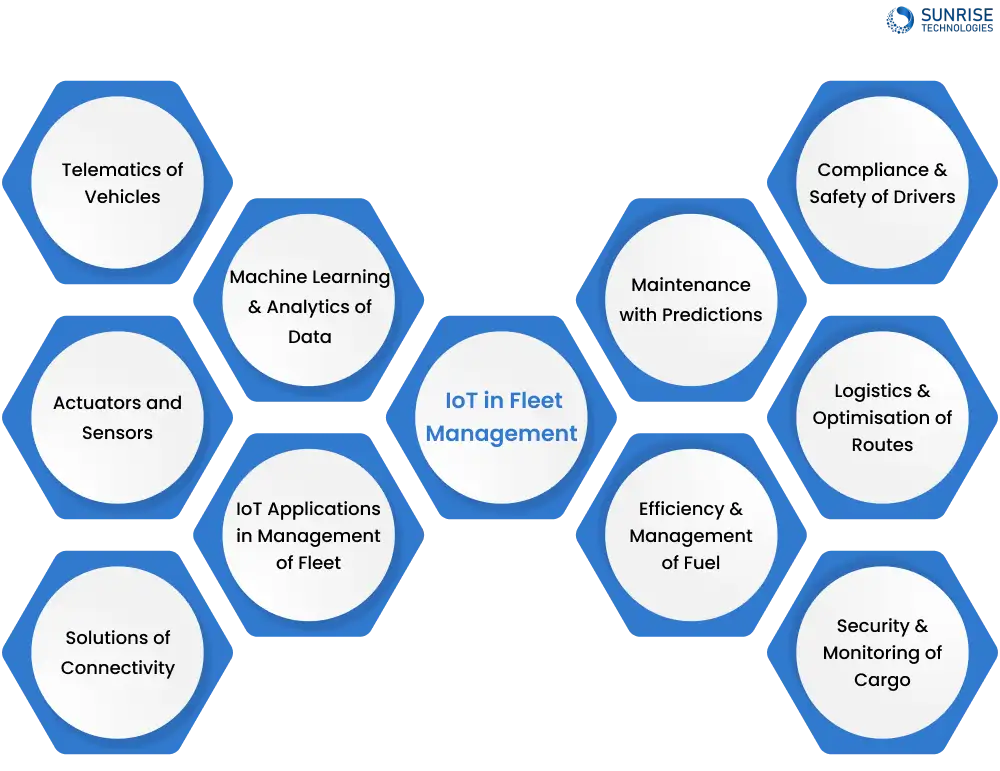
IoT system has integrated fleet management. It has transformed the business process for overseeing the operations of their vehicles. The technology of IoT helped in enabling monitoring in real-time, analysis and collection of various fleet operations aspects. It leads to improvements in safety, efficiency and cost savings. We will go through this article more. Where we will discuss the application and trends of the system of IoT in fleet management.
Coordination and supervision of commercial vehicles are included in fleet management. It consists of buses, cars, trucks and vans. They are used for delivery, transportation or service. Systemic management of the fleet consists of the optimisation of the usage of vehicles. It decreases the costs of operations. It ensures conformity to regulations. Thus, it improves productivity.
Managers of the fleet rely on methods that are traditional and manual. It separated the system that can track vehicles. It can also manage schedules of maintenance. It can also monitor the behaviour of the driver. However, with the arrival of the technology of IoT. Fleet management has shifted to a new pattern. It offers unmatched monitoring capabilities. And capabilities in decision-making and analysis.
IoT systems grasp the interconnected sensors. It also grasps software platforms and devices that are interconnected. It is for the transmission, collection and analysis of data. That also from vehicles and environments nearby. By integrating of solution of IoT into the management operations of the fleet, businesses obtain access to a wealth of information in actual time. It helps in the empowerment of enlightened decision-making. Thus, helping in the optimisation of the performance of the fleet.
Telematic devices are installed in vehicles. They help with the collection of data on location. Fuel consumption, speed, behaviour of the driver and diagnostics of the engine. These devices help in the transmission of data to centralised servers. It is used for interpretation and analysis.
Sensors that are enabled by IoT assist in the monitoring of certain parameters like humidity, temperature, pressure of the tyre and status of the cargo. Actuators help in enabling remote control for the functions of the vehicles. For instance, locking of the door and immobilisation of the engine.
IoT systems rely on the communication of wireless technologies. For instance, Wi-fi, cellular networks, and satellite links. It is to the transmission of data between vehicles, servers of the backend and infrastructure.
Algorithms of advanced analytics help in analysing of data of IoT. It is in identifying patterns, trends and anomalies. Machine learning models help in enabling the maintenance by prediction. It also enables analysis of the behaviour of the data and optimisation of the route.
GPS trackers that are enabled by IoT provide visibility in actual time. And, for the vehicle status in the fleet. Managers of the fleet can help in monitoring the movement of the vehicles. It also helps in tracking the utilisation of assets. They also help in efficiently optimising routing for operations.
Sensors of IoT help in the collection of data on the health indicators of the vehicle. It is also referred to as a vehicle health monitoring system by some people. Data consists of oil quality, engine performance and brake wearing. Algorithms from the maintenance by prediction help in the analysis of data. The data helps in the identification of possible failures. That too before occurring. Thus, it helps in enabling dynamic scheduling of maintenance. It also decreases downtime.
IoT systems help in monitoring the patterns of consumption of fuel. It also monitors the behaviour of the drivers and idle times. It is to identify opportunities for reduction of emissions and savings of fuel. Alerts in real-time help in notifying fleet managers of refuelling in an unauthorised way, theft of fuel and inefficiency in practices of driving.
Solutions of IoT help in tracking the behaviour metrics of the driver. Metrics such as harsh braking, speeding and unrestricted acceleration. Managers of the fleet can use this data to coach the drivers. It also enforces safety policies. It also ensures compliance with regulations. With regulations of hours of service. It also ensures inspection of the requirements of vehicles.
Solutions of IoT help in tracking the behaviour metrics of the driver. Metrics such as harsh braking, speeding and unrestricted acceleration. Managers of the fleet can use this data to coach the drivers. It also enforces safety policies. It also ensures compliance with regulations. With regulations of hours of service. It also ensures inspection of the requirements of vehicles.
Sensors of IoT are equipped with the capabilities of geofencing. It is for monitoring the integrity of the cargo. It also detects tampering or access performed in an unauthorised manner. It sends alerts to the fleet managers if there is any possibility of a security threat. It also enables prompt intervention. It also measures the reduction of risks.
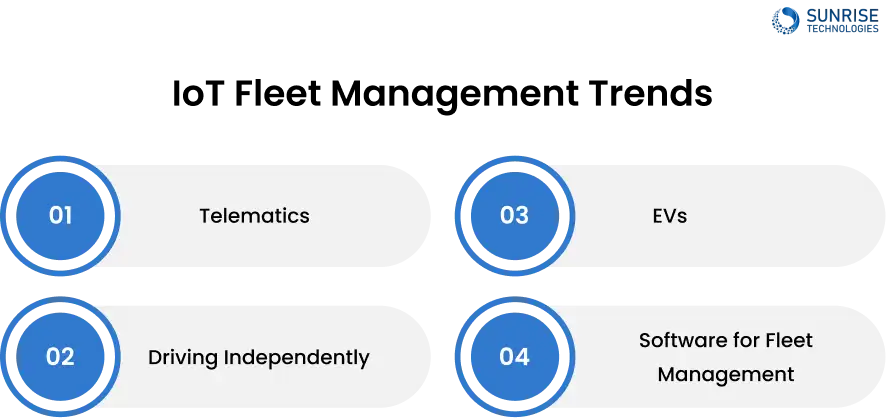
The combination of informatics and telematics is not new in development. But it has become common nowadays. That too immensely. Even people who own private cars opt to use modern-day trackers more frequently. They also opt for telematic apps that are compatible. They are compatible with receiving the benefits of insurance. Benefits of practising safe driving.
Commercial vehicles are not only advantageous with the rewards of insurance. But they also utilise the technology of telematics. It is to monitor the behaviour of the driver. It can also make interventions if there is any necessity for the safety and well-being of the driver. Telematics is expected to be much more advanced in the future. It has become more extensive than it is at present.
Driving independently is not as extensive as any other technology. But it is expected to be a major trend in the future. It aims to make improvements in road safety. It improves by decreasing the number of accidents that are caused due to mistakes caused by humans. With self-driven cars, there is no requirement for the human driver for each of such vehicles. It is making logistics and transportation more dependable and efficient.
In the automotive industry, cars with combustion engines are becoming obsolete gradually. With more and better dependable technology. Electric vehicle (EV) production is elevating constantly. Its corresponding infrastructure will also increase in a constant mode. To remain competitive and decrease footprints of carbon, businesses must upgrade their fleet of vehicles. They can be replaced with EVs as early as possible.
With the use of software solutions like fleet management or Fleet monitoring software, businesses can improve efficiency at work. They can also decrease the running costs.
Some challenges faced by the operators of the fleets are also involved in these advantages. The advantages that are offered by solutions of IoT fleet management. The following are some of the important advantages that an enterprise can gain by utilising solutions for IoT fleet management.
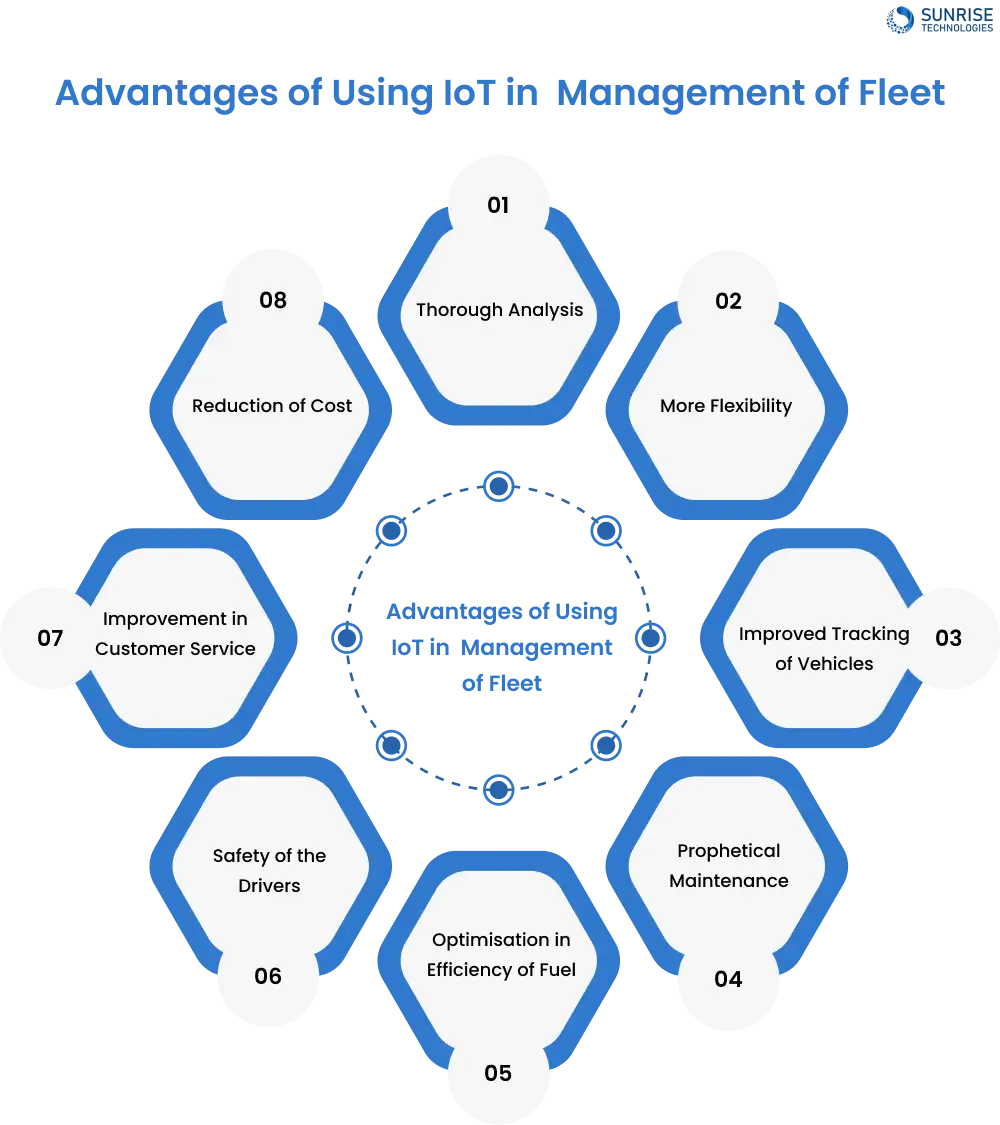
Sensors of IoT can gather huge amounts of information. It includes downtime, usage, fuel usage and location and health of the vehicle. Businesses check the data in clean statistics and analysis. It allows them to gain an intense understanding of their vehicles and assets. With the help of this knowledge, they can make well-informed decisions. It is regarding maintenance, safety and utilisation.
Fleet management software that is cloud-based can offer more flexibility. Especially when it comes to models of modern and advanced works. Information can be retrieved by the employees. They can retrieve it from anywhere and anytime. Especially if internet connectivity is available. It thus makes remote tasks easy for the operators and managers of the fleet. Drivers can also retrieve crucial information on-route. It allows them to stay updated on all necessary matters.
One of the main advantages of IoT in the management of fleets is improved tracking capabilities of vehicles. GPS tracking systems enabled by IoT allow fleet managers to monitor the exact location. As well as the vehicles’ movement in actual time. This visibility efficiently helps in the planning of the route. It also enables enhanced dispatching and response to the inquiries of the customers on time. Moreover, it helps in the prevention of the use of unauthorised vehicles, misuse and theft. It further enhances the protection of the assets and security.
Tracking in real-time also facilitates dynamic decision-making. Which is in unforeseen events. Such as accidents, congestion to traffic, unfavourable conditions of the weather or accidents. By grasping data of IoT, managers of the fleet can adversely vehicle rerouting, adjustment of routes and optimising schedules of delivery. It is for decreasing delays. It also ensures arrivals on the actual time.
Furthermore, tracking systems enabled by IoT provide historical analytics and data. It enables analysis of performance. Identifying the trends and optimising utilisation of the fleet. By analysing data on historical routes and patterns of traffic, managers of fleets analyse inefficiencies, decreased consumption of fuel and optimisation of routes. Thus, it leads to important savings in cost and advantages of the environment.
Another important advantage of IoT in the management of fleets is its predictive or prophetical maintenance. Sensors that are enabled by IoT and devices of telematics monitor the health of vehicles. It also monitors real-time parameter performance. It enables detection at an early stage. It detects the possibility of issues. And the intervention of maintenance proactively. Data analysis on the diagnostic of the engine, consumption of fuel, wearing of the tyre, and other evaluative components that can be identified by the managers of the fleet. It can identify issues appearing before escalation. Escalation of expensive breakdowns or safety risks.
Managers of the fleet are enabled by the maintenance of predictions. It is for the optimisation of the inventory of spare parts. They also optimise streamlining of maintenance of workflows, and allocation of resources. That is also more effective. Making focus on the resources of the vehicles requires attention instantly. Companies can give priority to maintenance activities. It decreases disruptions in ongoing operations.
Fuel denotes an important cost of operations for the operators of the fleet. It thus makes it a high priority to optimisation of efficiency of fuel. The technology of IoT plays an important role in the optimisation of the efficiency of fuel. It is by providing insights in actual time. Insights of actual time into the performance of the vehicles, consumption patterns of the fuel, and behaviour of the driver. Onboard sensors and telematics devices help in parameter monitoring like acceleration, speed, idling of the engine and efficiency of the route. It enables managers of the fleet to identify opportunities. It is for savings of the fuel and decrease of the emissions.
By analysing data on the consumption of fuel and the behaviour of the driver, managers of the fleet can identify inefficiencies. Implementing the right measures and qualified drivers for adopting more driving habits for efficiency of fuel. Solutions of IoT also help in enabling strategies of fuel management implementation. Such as optimisation of routes, maintenance of vehicles, and purchasing decisions for fuel. Decisions are based on market prices on actual time.
Furthermore, facilitation of fuel card data integration, telematics of vehicles and transaction of fuel pump. All of these are into a centralised platform. It also provides complete visibility. Along with that control over usage and expenses of fuel. By monitoring trends in fuel consumption, detecting anomalies and enforcing efficiency of policies of fuel. Businesses can decrease the cost of fuel and impact the environment. Hence in achieving worthwhile goals.
Ensuring the safety of the drivers is supreme in the operations of fleet management. The technology of IoT helps in enabling analysis and monitoring of the behaviour of the driver in actual time. It also enables managers of the fleet to identify unsafe practices. It reduces risks and promotes safe driving habits. Devices that are telematic help in capturing data on the speed of the driver, braking, accelerations and obedience to traffic regulations. Thus, providing insights that are valuable into the behaviour and performance of the driver.
By analysing data of the driver and implementations of safety initiatives such as training programs for the drivers, coaching sessions and schemes of incentive. Businesses can decrease accidental risks, claims of liability and injuries. Moreover, the monitoring system of the drivers enabled by IoT can also detect distraction, fatigue and other factors of impairment. It allows managers of the fleet to intervene. It prevents possible accidents before occurrence.
Additionally, to improve the safety of the drivers, the technology of IoT improves the capabilities of emergency responses. It is done by providing alerts in actual time. It also sends notifications during accidental events. They also send during breakdowns or if there are any other emergencies or mishaps. Managers of the vehicle can track the location, condition and status of the vehicles from a distance. It enables dispatch of personnel support, services in emergencies and roadside assistance on time.
In the industry of competitive transportation, satisfaction to customers is an important differentiator. The technology of IoT helps in enabling businesses to deliver customer service of superior quality. It is done by providing communication, visibility and transparency in actual time. It is throughout the entire process of delivery. Tracking of the GPS helps customers track the location and status of their shipments in real-time. It does provide assurance and peace of mind. That also regards timeline delivery and exact order. Thus, IoT helps in seamless shipment monitoring.
Furthermore, fleet management platforms enabled by IoT help in enabling proactive mechanisms of communication and notification. It allows companies to keep customers attached to the status of the orders, unforeseen problems and delays. By providing resolution of inquiries to customers and updates on time, businesses can improve loyalty, trust and levels of satisfaction. Thus, leading to business repetition and positive referrals of word-of-mouth.
Moreover, the technology of IoT helps enable businesses to capture and analyse feedback from customers. And also analyse their metrics of satisfaction and preferences. Thus, allowing continuous enhancement of quality of service. Plus, performance of delivery. By grasping insights that are driven by data companies can determine areas for improvement. They can also determine the addressing of pain points of the customers and improve their experience.
Reduction of cost is an important objective of the operators of a felt. The operators who seek improvement in profitability and competitiveness. The technology of IoT offers innumerable opportunities. In reducing cost across various aspects of the fleet’s management operations. By optimising the utilisation of vehicles, consumption of fuel and efficiency of routes, companies can help achieve important savings. That too in expenses that are operational and resource utilisation.
Maintenance with predictions helps enable businesses to decrease downtime that was uncalled for. And, to decrease the deprecation of vehicles and cost of repairment. It thus results in improved utilisation of assets and management of the lifecycle. By making identifications in the issue of maintenance in the early stage. And, by making them address proactively. Businesses can also decrease expensive breakdown risks. Thus, they enable to enlarge the life of the vehicles.
The technology of IoT helps in enabling companies to optimise the allocation of resources. Enhance productivity and streamline workflows. Manual task automation, decreasing processes that are redundant and grasping insights that are driven by data. By implementing these businesses can achieve higher efficiency in operations. And, in the optimisation of resources. It thus leads to savings in cost. And improvement in profitability.
Moreover, the dynamic pricing model’s implementation is facilitated by IoT. They also facilitate forecasting of demands and strategies of inventory management. It also enables businesses to increase profitability and revenue. It is while decreasing inventory stockouts and cost for carrying.
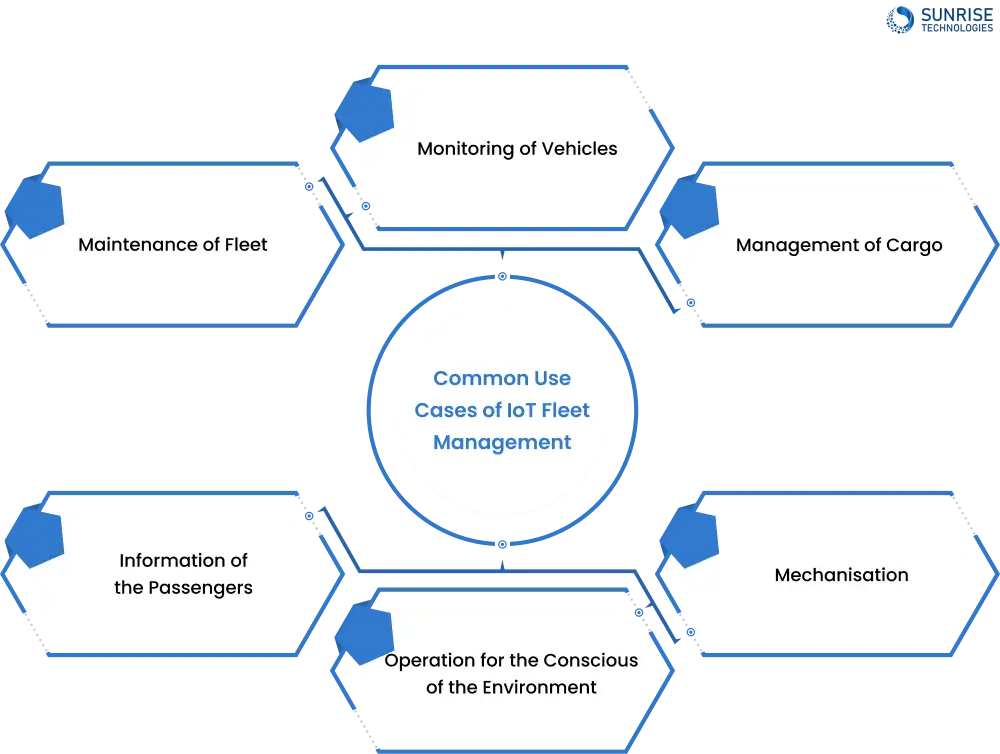
Analysis of data, Algorithms made with predictions and telematics infusion. They are all useful. Especially when it comes to primary issues in any vehicle. It also helps in the prevention of motor damage, batteries, brakes and tyres. Thus, it makes vehicles long-lasting and efficient.
Optimisation of algorithms, sensors and cameras helps in the analysis of data. They ensure the protection of vehicles. Fleets that are equipped with sensors give updates on time. They also give alerts as warnings if any parts have the requirement of checkup. Or they are close to being unsuccessful. Alerts like scheduled maintenance, battery life, and coolant temperature pressure of tyres. All these aspects help with the smooth running of vehicles.
Enhanced technologies like telematics with sensors, monitoring of temperature and surveillance play an important role in today’s logistics and supply chain. A check on different parameters of the environment. It helps in keeping those items safe that are perishable. Cameras and other sensors also help ensure the welfare and protection of the cargo.
Buses and other passenger vehicles that are enabled by IoT help in providing information. Information on routes, services and fares. It helps in informing passengers about regulations and rules. It is while providing services like Wi-fi and paperless ticketing. Video surveillance can be accessible by the operators of the bus. It is to gather data about defaulters, passengers and other protocols.
Using the technology of IoT, managers can track the behaviour of the drivers and get updates on actual time. It can help to reduce issue-related behaviours like over-speeding, wastage of fuel, and rash driving. Inactive vehicles are the actual emitters of carbon. IoT can help businesses to cut down on these practices. It is for saving your capital. And be friendly to the environment.
If you are thinking to mechanise the management of your fleet, IoT will help in flawlessly mechanizing various processes. It also helps with the flawless mechanization of your trip planning. Whether it is a selection of fast routes breakdown of vehicles or sending messages to be warnings or alerts, IoT can help you to make your management fleet aware. That too makes it less interesting for humans.
They are providers of solutions for data analytics and SaaS fleet management. They are said to be the discoverers of Transportation technology. For inconsiderate driving, they have released SmartSense. Integration of SmartSense, AI for inattentive driving or inattentiveness in general. Along with a camera that faces the cab. SmartSense also has computer vision for detection of drowsiness, usage of cell phones, smoking and inattention. It also sends alerts to the drivers to take necessary action to avoid collision.
They partnered with Intel to create a solution based on vision. It is for the safety of the assets and operations of the vehicles. Built-in sensors and 360-degree cameras help in the high-resolution streaming of vehicles. It helps to prevent theft and collision by automatically identifying unusual activity around the vehicle.
It is a French company that was formed in 2019. It was formed as a joint venture between Sigfox, Argon and Michelin. It was launched as a system for tracking assets. The launch was made with the help of Azure IoT fleet management. Trackers are on assets. And connected to the network of Sigfox OG. With its help managers can track the exact location of pallets, trailers or industrial tools of geolocation. That too in actual time.
To stay competitive in this breakneck industry like transportation and logistics, businesses need to stay ahead. That is also the adoption of modern solutions. One such solution is the implementation of IoT in the management of the fleets. It can help in addressing challenges like safety and health. Compliance and requirements of maintenance. And, in the management of fuel and utilisation of assets.
With the help of applications like Flyde, businesses can save their resources and money, and optimise their usage and operations improvement. It is developed by Sunrise Technologies. As a presenter of this article, we are also one of the leading companies in blockchain and app development.
Sam is a chartered professional engineer with over 15 years of extensive experience in the software technology space. Over the years, Sam has held the position of Chief Technology Consultant for tech companies both in Australia and abroad before establishing his own software consulting firm in Sydney, Australia. In his current role, he manages a large team of developers and engineers across Australia and internationally, dedicated to delivering the best in software technology.





Let’s create something extraordinary. Connect with Sunrise Technologies today!

MLC Centre, 19-29 Martin Place, Sydney, Australia 2000

56 Palmerston St, Perth WA 6000, Australia 2000

14 Mason Street , Melbourne, VIC 3175, Australia 2000

80 Ann, Brisbane, QLD-4000, Australia 2000

Level 7, 143, MGR Main Rd, Perungudi, Chennai - 600096, India

Binary Tower, 20th Floor, Office Number 96, Business Bay, Dubai, UAE
You cannot copy content of this page
Get a FREE estimate and business plan for your mobile app idea.